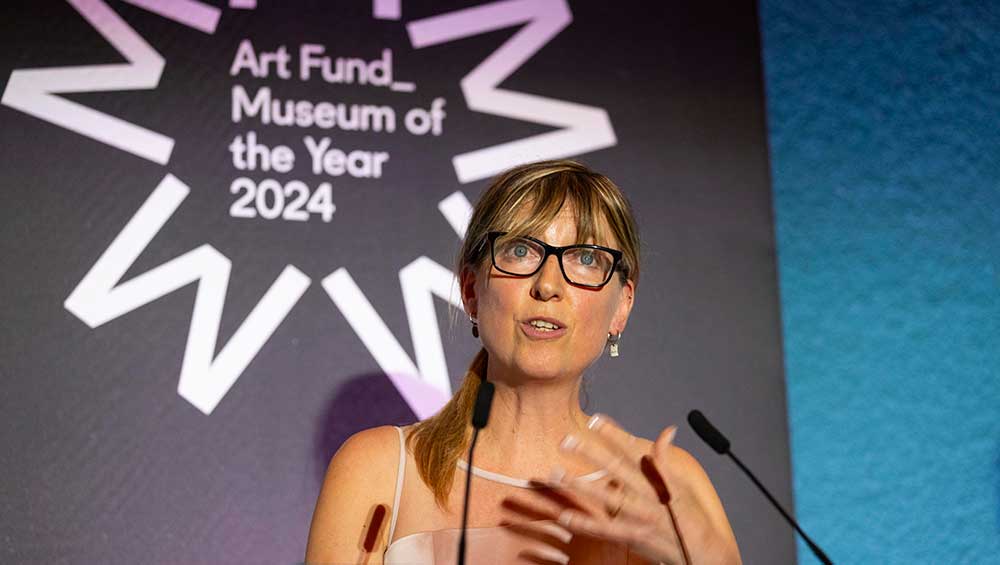
Dr Helen Charman, Director of the Young V&A, winners of Art Fund Museum of the Year 2024 at the National Gallery in London. Photo: David Parry, PA Media Assignments.
by NICOLA HOMER
The Young V&A in London has won a significant museum prize. In July, its director, Dr Helen Charman, was presented with the £120,000 prize for the Art Fund Museum of the Year 2024 award by the broadcaster Vick Hope, at a ceremony at the National Gallery in its bicentennial year. The award, the largest museum prize in the world, enables Young V&A to enhance its local community programme and to establish it as a regional and national resource, while acknowledging its reach to international audiences.
Situated in Bethnal Green in east London, the Young V&A has become internationally recognised as a children’s museum with a collection of art, design and performance at its centre. While the institution has a heritage that dates back more than 150 years to the Victorian era, the museum was given a new lease of life thanks to a £13m, six-year renovation project to transform the museum into a hub of creativity, so that it becomes a national resource. Opened last July, the museum was co-designed with children, becoming a place with a trio of innovative galleries for play, imagination and design, where visitors can find inspiration in almost 2,000 toys, characters, objects and artworks from different times and places across the world. Testament to its appeal and impact, the museum has welcomed 730,526 visitors in its first year.
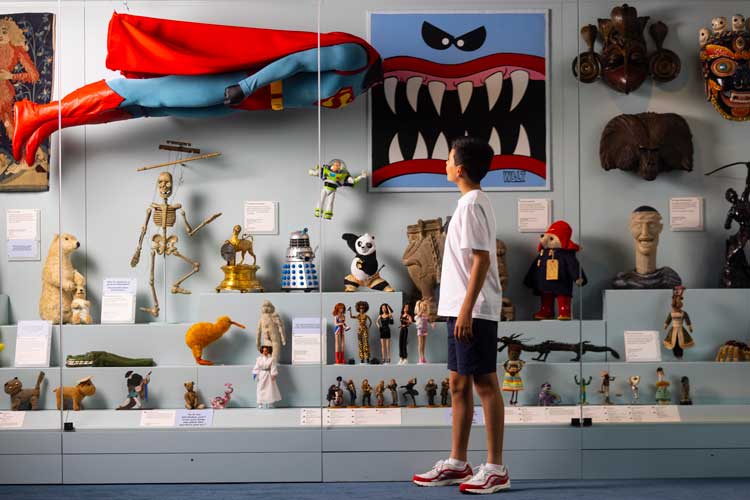
Young V&A, Museum of the Year 2024. Image courtesy of Victoria and Albert Museum, London.
Jenny Waldman, director of the Art Fund and the chair of the judges for the award, said of the experience offered by the museum: “Young V&A is a truly inspirational museum. With a brief from its young co-designers to create ‘the world’s most joyful museum’, Young V&A has achieved that and more. It has radically reimagined the museum with and for young people, creating a museum experience that’s active, empowering and dynamic, centred on learning through play. Young V&A has established a deep engagement with its local community and, at the same time, it has become an international beacon for what a children’s museum can be.”
The 2024 award acknowledged the contribution of inspiring projects from autumn 2022 until winter 2023 that placed audiences and communities at their heart, while focusing on community engagement, sustainable ways of working and best-in-class ambitions for present day and future audiences. The judging panel included the University of Dundee Professor Tania Kovats, an artist who focuses on the experience of landscape, Sir John Leighton, former director-general of the National Galleries of Scotland, Anupam Ganguli, finance director at Historic Royal Palaces, and Vick Hope. This year’s other shortlisted museums were the Craven Museum in Skipton, North Yorkshire; Dundee Contemporary Arts, Manchester Museum, and the National Portrait Gallery in London, each of which received a £15,000 prize.
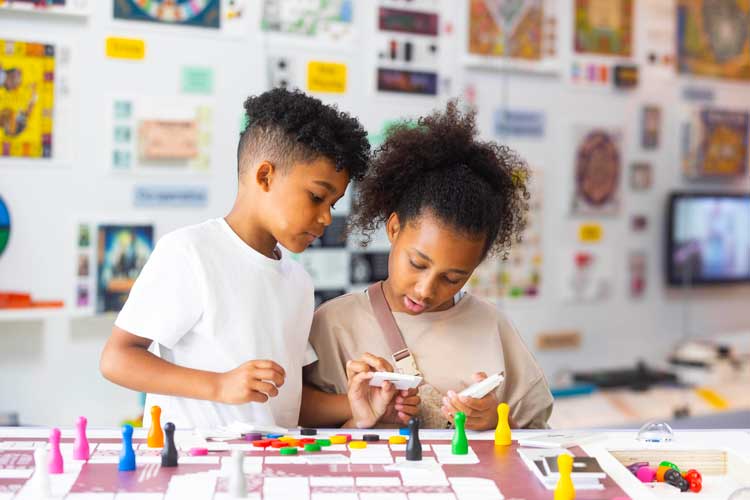
Young V&A, Museum of the Year 2024. Image courtesy of Victoria and Albert Museum, London.
Studio International spoke by telephone to Dr Helen Charman about the museum’s achievement, its journey of creative transformation, involving a process of co-design with children, how it presents opportunities for creativity and playful learning, and the possibility of having a positive impact on deprived children living in London. The following text is an edited excerpt from that conversation.
Nicola Homer: I would like to congratulate you on winning the Art Fund Museum of the Year 2024 prize. How did the Young V&A become an international beacon for what a children’s museum can be, which was the achievement recognised by the Art Fund’s director and chair of judges for the prize, Jenny Waldman?
Dr Helen Charman: We have been on site as a museum in this area of London, in Bethnal Green, since 1872. We’re in the building that was the original building for the South Kensington Museum that housed some of the exhibits from the 1851 Great Exhibition. In 1872, a call went out across London: were any of the other areas of London interested in having this rare example of Victorian top-lit architecture as a community museum? Bethnal Green was the only borough at that time to put its hand up and say, actually yes, we would like the building. So, the museum was dismantled. The story goes that it would have been put in pieces on the back of a portable cart, taken across London, from west London to east London, part of this Victorian project of regeneration. Here we are now, 152 years on, the site has been through various incarnations. Formally, it was the Bethnal Green Museum – it had different collections of science. In 1922, the head curator Arthur Sabin started collecting toys because he could see that children were visiting the museum and there was very little to directly engage them.
It then became the Museum of Childhood and on 1 July 2023, it reopened after a six-year transformation capital project into the Young V&A. So, from the outset, this project was to revivify, transform, radically change what the museum had been to become a powerhouse of creativity and playful learning that we co-designed with children, with young people, with their caregivers, educators and carers, but with children really at the centre of the museum, so that it becomes a very local community resource in the first instance.
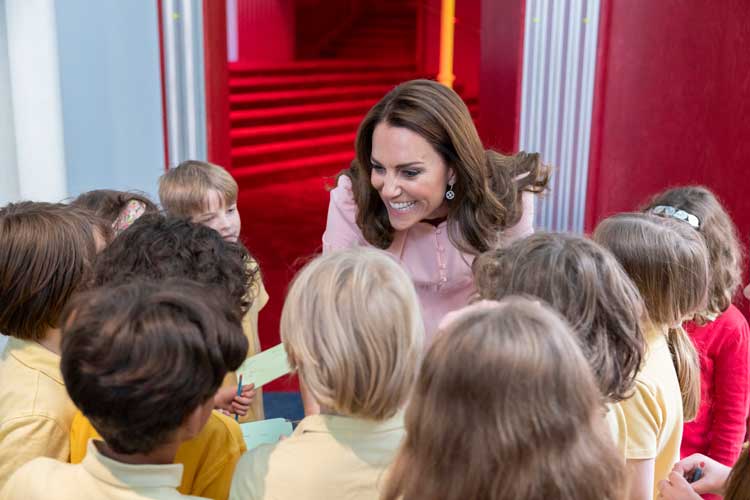
Young V&A, Museum of the Year 2024. Image courtesy of Victoria and Albert Museum, London.
It’s also a national resource because we are a national museum. Over the last year, since we’ve opened, it’s been visited by museum peers from all over the world, who were really interested in what a children’s museum can look like that has a world-class collection still at the centre. There are many fantastic children’s museums around the world, but there are not that many examples that have a collection of art, design and performance at the heart. I think this is what makes the Young V&A such an exciting, trailblazing project in the museum sector. That fantastic endorsement from the Art Fund for the international work, I think, is to do with the level of interest that we have had. We’ve had visitors from Japan, from India, from Brazil. The level of interest has been phenomenal. Everyone across the sector who is interested in working with children, with early years, with young audiences, we are all trying to figure out how you create museum spaces that are really relevant to the interests and needs of young people.
NH: I understand the Young V&A offers three innovative permanent galleries called Play, Imagine and Design. How does the museum present opportunities for young people to engage with themes of play and creativity?
HC: Playful learning and play and creativity run throughout all the Young V&A, and it’s in the visual design language of the displays – it’s very witty, an invitation to engage – but also through the interactives and through the way that content is displayed and the selection. So, for example, if we look at the Play Gallery, at one end of the gallery is what we call the Mini Museum, and this is a space for under-twos. It’s a beautiful, light-filled sensory environment, objects are displayed at toddler height. There are lots of opportunities for toddlers who are just learning to pull themselves up, to peer over, to crawl, curated around sound, colour and texture. There are these fantastic bright-coloured objects of colours of the rainbow. There is a beautiful Sound Tree, we call it: a big cabinet that opens up with objects that make sounds that relate to objects in the artworks, the design works in the space. The landscape reflects the quality of the objects, so if it’s a marble sculpture then it’s in a marble landscape, and the child can look and feel, and make that connection, and is underpinned by the learning in childhood development around essentially learning from play, so experiential, sensory, responsive, relevant, and you are in an environment that really meets the child on the child’s terms, so thinking about where children are in their developmental journey, then the displays are designed and developed to respond to the children at that stage.
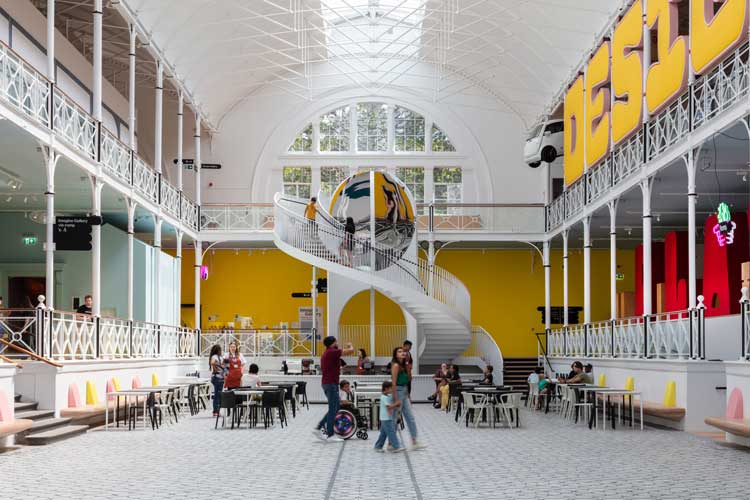
Young V&A, Museum of the Year 2024. Image courtesy of Victoria and Albert Museum, London.
At the end of the Play Gallery, we have a space called the Arcade, which is all about the mechanics of game design and then the games table, where you can devise your own board game. There is a fantastic diorama with a massive open display of different types of board games from our collection with the mechanics of the skills that you are developing as you play those games. There is the museum that we built through Minecraft – we worked with Microsoft’s best world-builders – and then there are three digital games, including Monument Valley. You can play the games, but they are there so you can learn about how they have been designed. The whole language of play and engaging with the world through playful approaches is illustrated by the objects on display, but really importantly, you have then got a lovely interactive that engages you in the way that the objects on display would do were you able to play with them directly.
NH: I can appreciate that the objects are displayed in new ways to support young people’s development as you have described. Can you tell me about how you use ideas of storytelling to encourage community engagement?
HC: Yes. We have this space called the Town Square and the second half of it is where this lovely little cafe is and families can bring packed lunches, and they can use the space as they like, and we deliberately left a lot of that open, because we know that free civic space just to run around and play is at a premium, particularly probably in cities, and we use that space a lot for the performance things. But on one side of the gallery, the first floor then is the Play Gallery. Opposite it is the Imagine Gallery – which is all about storytelling – and there are a lot of objects there from our theatre and performance collection. The centre of it is this beautiful, enclosed, red velvety stage area, and kids can do their local performances there. We do a lot of storytelling in that space. On one side next to it is the Adventure Gallery with Hokusai’s print of The Great Wave and the Joey the War Horse model [based on the National Theatre’s adaptation of Michael Morpurgo’s novel] and in the Adventure Gallery, there are prompts across the walls – the idea is that you are creating a story, prompted by the object that you see. So, one wall may say, “Where are you going?”, and it’s a beautiful example of different kinds of landscapes, paintings and relief works from all around the world and across time. Then there will be another space that has a wall that will say, “Who are you going to meet?”, and in that cabinet, there will be a range of different characters that you might take with you. In the middle of that space is the Story Machine, which is like a Heath Robinson contraption, where you can turn a wheel and you’ll get a prompt for a story. So, there is a structure for telling your story, so the child is invited in to the storytelling mode, if you like, through the interactives, which are physically attractive and very playful. And then they look at the works and that’s when you then see the children coming up with their own ideas. There are little story tubes, listening tubes and speaking tubes: you can press a little button, tell your story at one end of the tube, and it wiggles around across the gallery, and then your friend will be listening at the other end. It’s very engaging. It’s great fun. It gets the children looking at the objects, that’s what we want to happen.
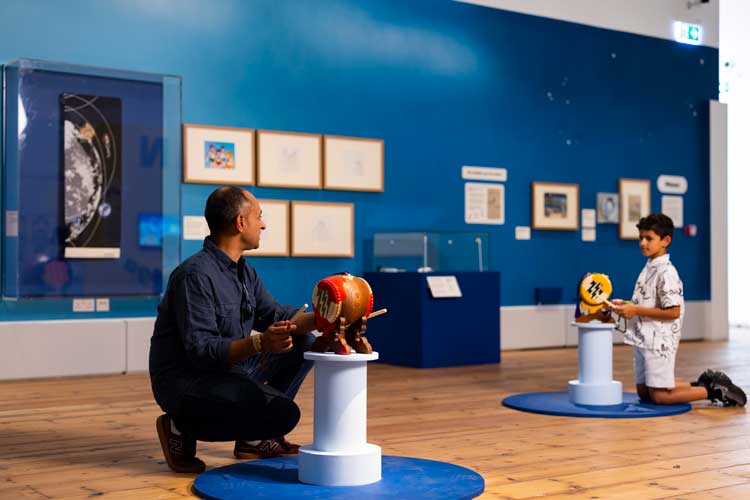
Young V&A, Museum of the Year 2024. Image courtesy of Victoria and Albert Museum, London.
NH: Thank you for talking about the design process. Now I can appreciate why the Young V&A has been described in the media as the “world’s most joyful museum”. I understand that in the process of its transformation, the young co-designers were presented with a brief. Can you tell me about the role of co-design and the transformation of the museum into what it is today?
HC: We knew that we wanted to co-design the museum. Good co-design takes a long time if you are going to do it in very embedded way. We were connecting the young people from local schools, two primary schools and one secondary school, with our architects, De Matos Ryan (DMR). Once that process, the base build, had been completed, we carried on doing co-design with our fit-out architects, Agents of Change (AOC). When we were doing the base build piece, with DMR, the children were working with the architects and with our teams of educators, and with their teachers and caregivers, on architectural elements around navigating the building. They had three areas: one was up and down, one was in and out, and one was around and about, so vertical circulation, access and exit, and also horizontal, navigating the building. In the end, the children decided they wanted to focus on vertical, the up and down bit. So, they were designing the beautiful, kaleidoscopic feature staircase, and then the ramp next to it, and that was inspired by our optical toys collection.
Again, everything always comes back to the collection. We are a museum, we have got collections, objects at the heart of the museum, but all those objects have to work really hard to inspire the child, to be relevant to the child. It was in those workshops, when we were iterating around the design, of what would become this fantastic, kaleidoscopic, helter-skelter shaped stair, that the children said to us that what they wanted was the world’s most joyful museum. So, in a way, it was a brief from the children back to us, back to our designers, and we just loved that. We thought, what a completely fantastic brief for a museum of creativity and play. So, the whole of Young V&A is a very optimistic space. It's airy, it’s colourful, it’s playful. On the welcome wall, as you come in, there is a sign that says “Joy this Way”. The kids come running in, they come in on their little bikes, scooters, sometimes they are dancing their way in, it just lifts the spirits. And then, of course, they’re in. Because children’s voices and creative agency and ideas are so embedded in the museum, children understand that it’s their space. They just get going. They have a great time and they’re learning at the same time.
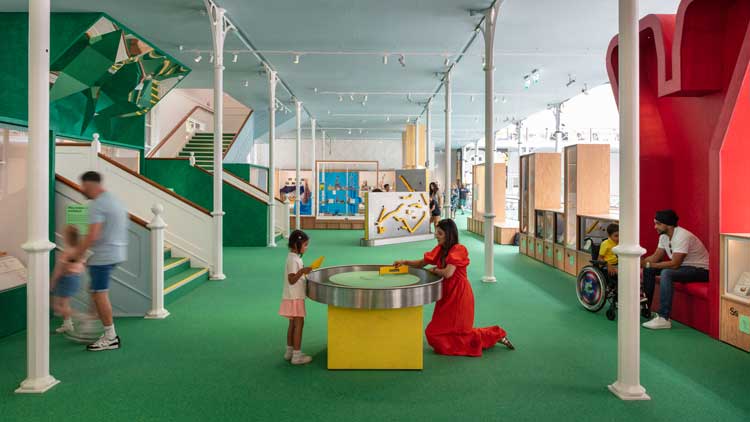
Young V&A, Museum of the Year 2024. Image courtesy of Victoria and Albert Museum, London.
NH: The Art Fund Museum of the Year award is one of the world’s biggest prizes for museums. At a time of a challenging funding climate for museums and perhaps underinvestment in creative education in many schools in the UK, I was wondering if you could offer any thoughts on how the prize money could make a difference to the community?
HC: The Young V&A is in Tower Hamlets, which has one of the highest levels of childhood deprivation in the country, and a very high level of multigenerational families. Children don’t have a lot of domestic space, so the resource in and of itself, the Young V&A being in Tower Hamlets, is really important, and we work very closely with the borough and it has a fantastic Play Charter. This exceptional prize fund of £120,000, which is just amazing, will enable us to create a network of partnerships along what we would call the Thames Estuary. So, we are very established now in Tower Hamlets. We work with organisations and schools, also in Newham, in Hackney, in Waltham Forest. But we want to move east along that Thames Estuary, the transport corridor out towards Southend-on-Sea, because also, looking at the YouGov data for there, we can see children living in families that are below the average income in the country. We think this will be a way of taking that resource and working in partnership with childcare centres, early years, to create opportunities for playful learning, for connecting with the collection, and connecting back to Bethnal Green, knowing that you’ve got good transport links in, so we can start to establish the Young V&A more widely as this community and regional and national resource.
NH: Excellent. Can you give an example of how you plan to establish the Young V&A as such a resource?
HC: Yes. We did a massive reopening outreach programme for the two years before we opened. In the end, we had worked with 22,000 children and families and young people in a programme and some of that was very deep and sustained work. So, an example would be working with a children’s centre to co-create a play-led series of activities, which will be stimulated through using some of our handling collection.
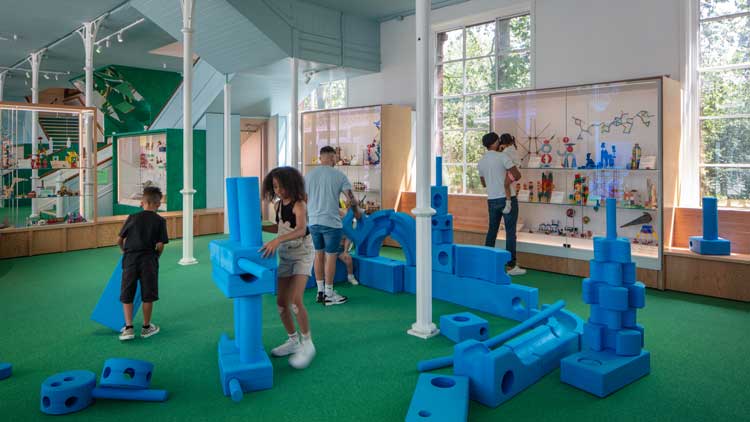
Young V&A, Museum of the Year 2024. Image courtesy of Victoria and Albert Museum, London.
NH: How do you think that sustainable ways of working could be achieved?
HC: These partnerships will be established and they will connect back into the core early years programming at the site. So, it’s also about audience development, knowledge development, practice sharing, reaching out to connect with new audiences and new communities in practice. We are cognisant of the impact of the post-Covid, cost-of-living crisis, the marginalisation of creative educational opportunities. We’ve been very thoughtful about how we can maximise this incredible resource to bring a sustained and indepth benefit for those children who may not otherwise have these experiences and this access to a very structured, playful learning approach.
NH: How do you think the Young V&A could have a positive impact on young people at this time?
HC: It’s about addressing some of the long tail of Covid, the impact for early years, which we can see from the YouGov stats on what is described as school readiness skills. So, one fact is that 38% of young children do not have what we would call “play skills”, being able to share, being able to take turns, or more widely effective communication. The impact of Covid, the impact of the cost-of-living crisis, using the incredibly generous prize fund to develop creative early years learning and play-led learning opportunities for communities who may not otherwise have those opportunities, and the museum also learning with and from those communities, will be one of the areas that we hope to make a positive contribution, and putting the museum on the map for families who might not otherwise know that the Young V&A exists as a free, civic, play-led space for them and their children.
NH: That is an excellent point. Is there anything you would like to add?
HC: Just a huge thanks to the Art Fund and to our judges. It’s a real honour and a privilege. It’s an acknowledgement of how much need there is for investment in creative education and in playful learning for our youngest. That would be, I think, the clarion call for recognition of the need for that.
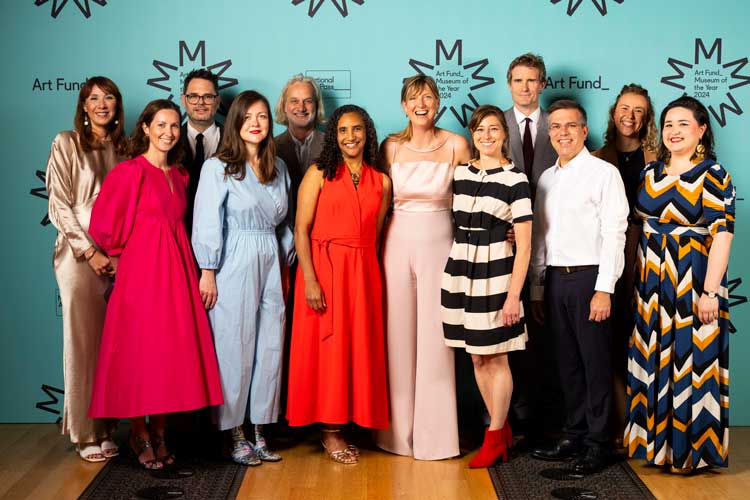
The team from the Young V&A, winners of the Art Fund Museum of the Year 2024, at the award ceremony at the National Gallery in London. Photo: David Parry, PA Media Assignments.